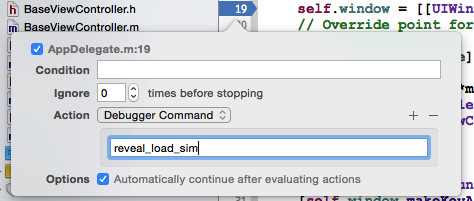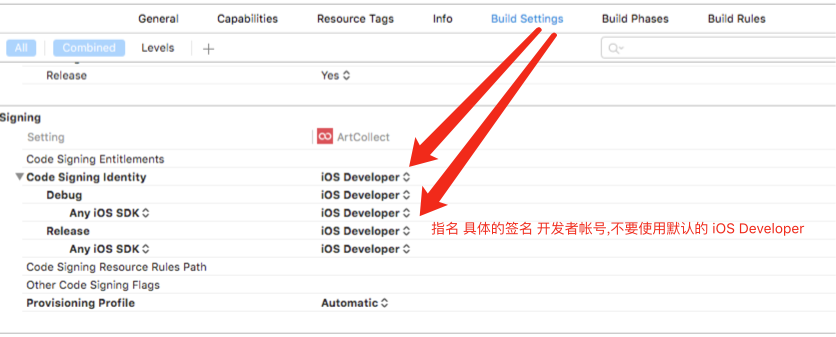Reveal
- 时时查看 真机或模拟器 的UI 显示 情况;
- 界面动态修改UI 控件的参数,无需代码,无需重启程序 一切 xib 中有的参数,都可以调整,包括约束更新
- 对于越狱机器 , 还可以在逆向工程中大展拳脚, 学习他人的 布局技巧
推荐使用官方最新教程
Reveal 的安装与配置问题
然而,上述好处的 所有种种, 前提是 你配置好了 相关的 软件. 下面我就将我遇到的相关问题 和 解决办法 罗列出来, 希望其他人不要再踩坑.
动态方式配置 Reveal <推荐方式>
OC模拟器
首先创建lldb指令文件
vim ~/.lldbinit
千万 千万不要粘贴错误. 如果经过一下步骤,仍然出问题, 先检查一遍这个文件.
检查方法,首先将本隐藏文件显示出来,方法如下
// 显示所有文件, 包括隐藏文件
defaults write com.apple.finder AppleShowAllFiles Yes && killall Finder
如果不想使用命令行,推荐CommanderOnePro软件
将lldb指令输入到本文件中. 要注意粘贴的时候不要漏掉任何字符
command alias reveal_load_sim expr (void*)dlopen("/Applications/Reveal.app/Contents/SharedSupport/iOS-Libraries/libReveal.dylib", 0x2);
command alias reveal_load_dev expr (void*)dlopen([(NSString*)[(NSBundle*)[NSBundle mainBundle] pathForResource:@"libReveal" ofType:@"dylib"] cStringUsingEncoding:0 x4], 0x2);
command alias reveal_start expr (void)[(NSNotificationCenter*)[NSNotificationCenter defaultCenter] postNotificationName:@"IBARevealRequestStart" object:nil];
command alias reveal_stop expr (void)[(NSNotificationCenter*)[NSNotificationCenter defaultCenter] postNotificationName:@"IBARevealRequestStop" object:nil];
注意:这几个lldb指令,只使用于OC的项目,而且只是模拟器.
OC真机
会遇到下面的问题
error: no known method '-cStringUsingEncoding:'; cast the message send to the method's return type
error: 1 errors parsing expression
解决方法: ①第一步:
command alias reveal_load call (void*)dlopen((char*)[(NSString*)[(NSBundle*)[NSBundle mainBundle] pathForResource:@"libReveal" ofType:@"dylib"] cStringUsingEncoding:0x4], 0x2);
该指令是用reveal_load替换原来的reveal_load_sim和reveal_load_dev 指令,This will ensure that if Reveal is already loaded, calling the command again will not try to load the library a second time.
建议将.lldbinit文件中的指令修改为 :
command alias reveal_load call (void*)dlopen((char*)[(NSString*)[(NSBundle*)[NSBundle mainBundle] pathForResource:@"libReveal" ofType:@"dylib"] cStringUsingEncoding:0x4], 0x2);
command alias reveal_start expr (void)[(NSNotificationCenter*)[NSNotificationCenter defaultCenter] postNotificationName:@"IBARevealRequestStart" object:nil];
command alias reveal_stop expr (void)[(NSNotificationCenter*)[NSNotificationCenter defaultCenter] postNotificationName:@"IBARevealRequestStop" object:nil];
模拟器中添加断点:

而且此方法在切换真机与模拟器时,不需要更换断点的指令
② 第二步:
在applicationDidBecomeActive方法中调用 loadReveal方法
#import <dlfcn.h>
#pragma mark - Reveal
- (void)loadReveal
{
if (NSClassFromString(@"IBARevealLoader") == nil)
{
NSString *revealLibName = @"libReveal"; // or @"libReveal-tvOS" for tvOS targets
NSString *revealLibExtension = @"dylib";
NSString *error;
NSString *dyLibPath = [[NSBundle mainBundle] pathForResource:revealLibName ofType:revealLibExtension];
if (dyLibPath != nil)
{
NSLog(@"Loading dynamic library: %@", dyLibPath);
void *revealLib = dlopen([dyLibPath cStringUsingEncoding:NSUTF8StringEncoding], RTLD_NOW);
if (revealLib == NULL)
{
error = [NSString stringWithUTF8String:dlerror()];
}
}
else
{
error = @"File not found.";
}
if (error != nil)
{
NSString *message = [NSString stringWithFormat:@"%@.%@ failed to load with error: %@", revealLibName, revealLibExtension, error];
UIAlertController *alert = [UIAlertController alertControllerWithTitle:@"Reveal library could not be loaded"
message:message
preferredStyle:UIAlertControllerStyleAlert];
[alert addAction:[UIAlertAction actionWithTitle:@"OK" style:UIAlertActionStyleDefault handler:nil]];
[[[[[UIApplication sharedApplication] windows] firstObject] rootViewController] presentViewController:alert animated:YES completion:nil];
}
}
}
//-------------------------------------------
// 细节发布版本的屏蔽此方法:
# DEBUG
[self loadReveal];
#endif
//-------------------------------------------
③ 第三步:
真机测试时,需要xcode和真机在同一个局域网下.
真机测试时,证书签名的问题ambiguous说明你指定了多个开发者帐号
解决办法:

swift 项目
报错: swift 没有(void*) 类型,所以要自己删除(void*),其他指令不便
静态方式 Reveal.framework
报错
添加编译指令-ObjC -lz -framework Reveal时
多处报错duplicate symbol ,这是因为 与项目中其他的静态库发生冲突所致.
解决办法 : 具体分析报错原因,一般设置Other Flag 的相关配置就可以了
使用CocoaPods集成
官方全新教程
Load the Reveal Server via an Xcode Breakpoint
The method described below only works for apps running in the iOS or tvOS Simulator.
Loading the Reveal Server framework via an Xcode Debugger Breakpoint is a great way to let you introspect any project you happen to be working on without needing to change anything in the project’s files. It also means you don’t need to worry about accidentally shipping a release build of your app linked with the Reveal library.
- Open your iOS or tvOS project in Xcode, and select View → Navigators → Show Breakpoint Navigator.
- In the bottom left of the pane, click the + button and select Add Symbolic Breakpoint.

-
Enter
UIApplicationMaininto the Symbol field. - Click the Add Action button, and ensure that Action is set to Debugger Command.
-
Copy and paste the following text into the field below:
For iOS targets:
expr (Class)NSClassFromString(@"IBARevealLoader") == nil ? (void *)dlopen("/Applications/Reveal.app/Contents/SharedSupport/iOS-Libraries/RevealServer.framework/RevealServer", 0x2) : ((void*)0)For tvOS targets:
expr (Class)NSClassFromString(@"IBARevealLoader") == nil ? (void *)dlopen("/Applications/Reveal.app/Contents/SharedSupport/tvOS-Libraries/RevealServer.framework/RevealServer", 0x2) : ((void*)0)Note: If necessary, update the path to Reveal.app above to the correct location for your Mac.
- Check Automatically continue after evaluating actions.

- Right click the newly created breakpoint and select Move Breakpoint To → User.

> You can enable and disable the breakpoint as you would any other. User breakpoints are available across all Xcode projects.
- In Xcode, build and run your application under the iOS or tvOS Simulator.

If everything worked, you should be able to switch to Reveal and see your iOS or tvOS application listed in Reveal. Select your app and verify that you can see a snapshot of the app matching what you see in the simulator.